|
HOME > TRAVELOGUE
> MONTEREY BAY, CA
Travelogue
Monterey Bay Aquarium
January 18, 2003
Monterey Bay, California, is only two hours south of Mountain View (where
I live as of this writing). It's where John Denver died, after the experimental
plane he was flying crashed into the Bay (bad
interface design killed John Denver).
Rash and I drove down to see the Monterey
Bay Aquarium, situated at the end of Cannery
Row which itself was made famous by John
Steinbeck. I liked this aquarium better than Baltimore's
National Aquarium, though it's been years since I've seen the latter.
I'll have to do a comparison when I'm back on the East Coast.
We spent most of the day looking at marine life, including the awesome
special exhibit of Jellies:
Living Art (we broke only for lunch at The Fish Hopper ... good service,
but the food was mediocre and overpriced). I think I could have easily
spent three days at the Aquarium and not have gotten bored.
There's a lot I didn't photograph: marine birds, octopi and squid, otters,
penguins, the splash zone (for kids), the petting pools, most of the artwork,
and more. Here's what I managed to record:
CLICK ANY IMAGE TO EXPAND
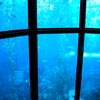 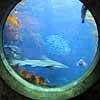 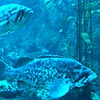
The Kelp Forest is a huge 335,000 gallon two-story tank
filled with Giant Kelp and others, and marine life. I
think that's a Soupfin Shark in the porthole (comparison).
Blue Rockfish swim on the edge of the kelp forest and
feed off jellies and plankton. "Groves of waving kelp form a sheltered,
sun-dappled forest." Waving indeed; it was hypnotic and I could have
watched it all day. The tank seemed to be gently breathing. [more]
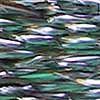 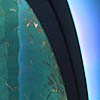 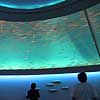
Like anchovies on your pizza? Either way, the Anchovy Cylinder
(left) is fun to watch. At the other end of the Aquarium there's also
the Anchovy Ring (center and right). In both, anchovy
schools swim in an endless circle.
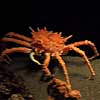 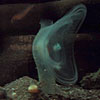 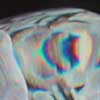  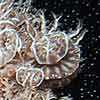
Alaskan and Spiny King Crabs (left)
live on the sea floor, 500-2,400 feet. In the enlarged photo the Spiny
King Crab is in front. The Predatory Tunicate (second
from left) is reminiscent of a Venus Flytrap. "Predatory tunicates
are simultaneous hermaphrodites—each animal produces both eggs and
sperm." [more]
Sand Dollars (center) fill this cool convex aquarium.
They can live to be 50 years old. Next is the amazing Leafy Sea
Dragon, a relative of the Seahorse. Dragons are perfectly camouflaged
against seaweeds and sea grasses [more].
I'm guessing that the last photo is a clump of Upside-Down Jellies.
"Upside down jellies don’t have a central mouth—instead
the edges of its eight oral-arms are fused and folded into elaborate frills
containing hundreds of tiny mouth openings." [more]
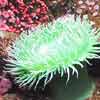 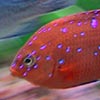 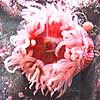 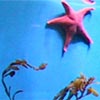 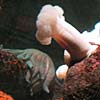
Anemone environments - Anemones are tentacled
sea creatures with tube-like bodies sometimes anchored up to two feet
in the sand (if they're the borrowing kind). Some anemones live 100 years
or more. They are home to many types of anemone fish, and stun prey with
their tentacles (anemone fish have a protective mucous to shield them
from stings). The sea star (aka starfish) in the fourth photo may be a
Bat Star, which eats plants and animals, dead or alive.
The anemone below it seems to be feeding, its tentacles withdrawn. Be
sure to notice the many-armed sea-star in the last image. (Second photo
by Rash)
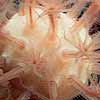 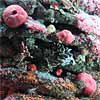 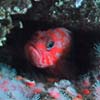
The Mushroom Soft Coral (left) "takes on two very
different shapes. When closed up tight, it looks like a mushroom. But
with tentacles outstretched to feed, it looks more like a flower."
[more]
The other corals and barnacles shown are living creatures
which help build reef environments and stud the Monterey Canyon walls.
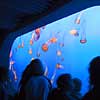 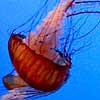 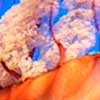 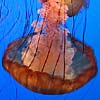
This tank of Black Sea Nettles was especially striking,
for the abundant large orange jellies floating in the blue lozenge, their
cloudy arms and long tentacles streaming behind. "The black sea nettle
is considered a giant jelly; its distinctive purplish bell [purplish?
... maybe the Aquarium's lighting brings out the orange] can reach over
three feet in diameter, its lacy, pinkish oral arms can reach nearly 20
feet in length and its stinging tentacles 25 feet or more." [more]
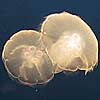 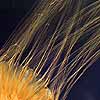 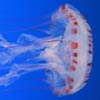 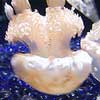
The Aquarium currently houses two great walls of Moon Jellies
(left), gently drifting. Also known as Saucer Jellies, they have a very
short fringe of tentacles. Next, the Lions Mane Jelly
(I could be wrong about this classification) is a giant jelly, with a
bell as large as 8 feet and tentacles 100 feet or more. Unfortunately,
I can't find a reference for the third photo, a white and red jelly. The
Spotted Jelly (right) have many small mouth openings
on their oral arms. Some of the larger spotted jellies—up to 2 feet
in diameter—actually have small fish living inside the bell.
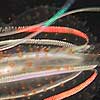 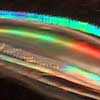 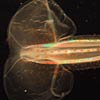 
I think most of these are Comb Jellies. "As they
swim, the comb rows diffract light to produce a shimmering, rainbow effect."
The little comb hairs are visible in the fourth photo, but the first three
are the most interesting for the undulating neon rainbow effect they produce
under the Aquarium's lighting. Some other jellies are bioluminescent,
but not these. [more]
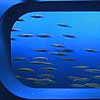 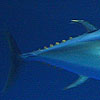
Fish from the outer Bay - This blue lozenge of unidentified
(by me) fish was striking. The second fish is either a Yellowfin
or Pacific Bluefin Tuna, one of the fastest fish in the
sea at up to 40 miles per hour.
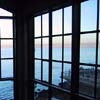 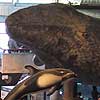
Here's a view of the Monterey Bay through the Aquarium
windows. Models of a Gray Whale and Common Dolphins
(among other marine mammals) hang from the Aquarium's ceiling.
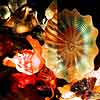 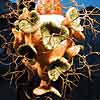 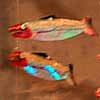
In addition to fish, birds, marine mammals and the like, the Aquarium
also offered marine-inspired artwork. Left is glass work
by the famous Dale Chihuly [more].
Center is a sea form entirely covered with beads (artist
unrecorded by me). At right is detail from a ceiling sculpture
hanging in one of the gift shops. The metal fish have an eye-catching
iridescent coating. Not shown here was a wall in a dark nook (across from
the Chihuly shown) which displayed two score Lava Lites, slowly bubbling
away. Also, plates by Ernst Haeckel, Tesla-coil art by
Cork Marcheschi, and other artists were exhibited.
|